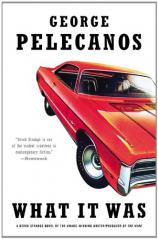What It Was
Review
What It Was
I was going to start this review with the words “I don’t think anyone is writing crime fiction with quite the style and authority of George Pelecanos.” I changed my mind. One cannot limit the magic that Pelecanos works to crime fiction, as wonderful, deep and wide as that genre may be. His considerable talent has been exhibited over the last several years in novels, television and film while winning a number of awards for his efforts along the way. In each, he has demonstrated a canny and frighteningly real understanding of the intricacies of street life, documenting and exhibiting the ley lines that connect seemingly disparate individuals and events in time and space. When reading any of his novels, and particularly his latest effort, one is put in the mind of the work of authors ranging from Nelson Algren to Robert Beck.
"Pelecanos begins ratcheting up the suspense from practically the first page, taking a story being told in a bar and transforming it into a trip to the past..."
WHAT IT WAS is probably best included in the Derek Strange canon. The time and place of the book is 1972, in Washington, D.C., where the aftermath of the violent riots of the late 1960s (if they ever actually ended) is still being played out. Strange, an ex-D.C. cop turned private investigator, is hired by a woman to find and retrieve a ring that was taken from her. Things are a bit more complicated than that, of course; the ring was stolen during the murder of her boyfriend, a low-level street thug named Bobby Odum. The doer is Red Jones, a force of evil nature who is known in the neighborhood as Red Fury, due to the distinctive automobile he drives. Jones is not reticent about claiming credit for the murder; in fact, he feels that it gives him street credibility as he works his way up the Washington, D.C., criminal ladder, robbing a heroin dealer and a numbers kingpin along the way.
The murder attracts the attention of Frank Vaughn, a D.C. homicide investigator who has plans to put Jones away for good. What is perhaps of more serious import for Jones, however, is that the heroin he boosted belonged to the New York mob, which, in turn, has dispatched a couple of stone-cold heavy hitters to D.C. to retrieve their merchandise and exact revenge. One can see where this book is heading in its early pages; the paths of Strange and Vaughn will intersect once again as they form an alliance of purpose as they move toward a collision course with Jones, who is possessed of a kind of strange respect for Vaughn’s tenacious pursuit of him. And, of course, the mob hit team is in pursuit as well.
Where Pelecanos really shines is in describing the journey to the destination. The popular music of 1972 is the soundtrack for the story, played on radios and apartment stereo systems and jukeboxes in smoky nightclubs, where violence can and does erupt quickly and fatally. Pelecanos begins ratcheting up the suspense from practically the first page, taking a story being told in a bar and transforming it into a trip to the past, elements of which remain the same as the present.
The title WHAT IT WAS, as it applies to the book, is both a street term in vogue at the time and a description of this dark tale of the past. It may ostensibly be a work of fiction, but truer stuff was never written.
Reviewed by Joe Hartlaub on March 8, 2012
What It Was
- Publication Date: January 23, 2012
- Genres: Fiction, Hard-boiled Mystery, Mystery, Suspense, Thriller
- Paperback: 272 pages
- Publisher: Reagan Arthur / Back Bay Books
- ISBN-10: 0316209546
- ISBN-13: 9780316209540





